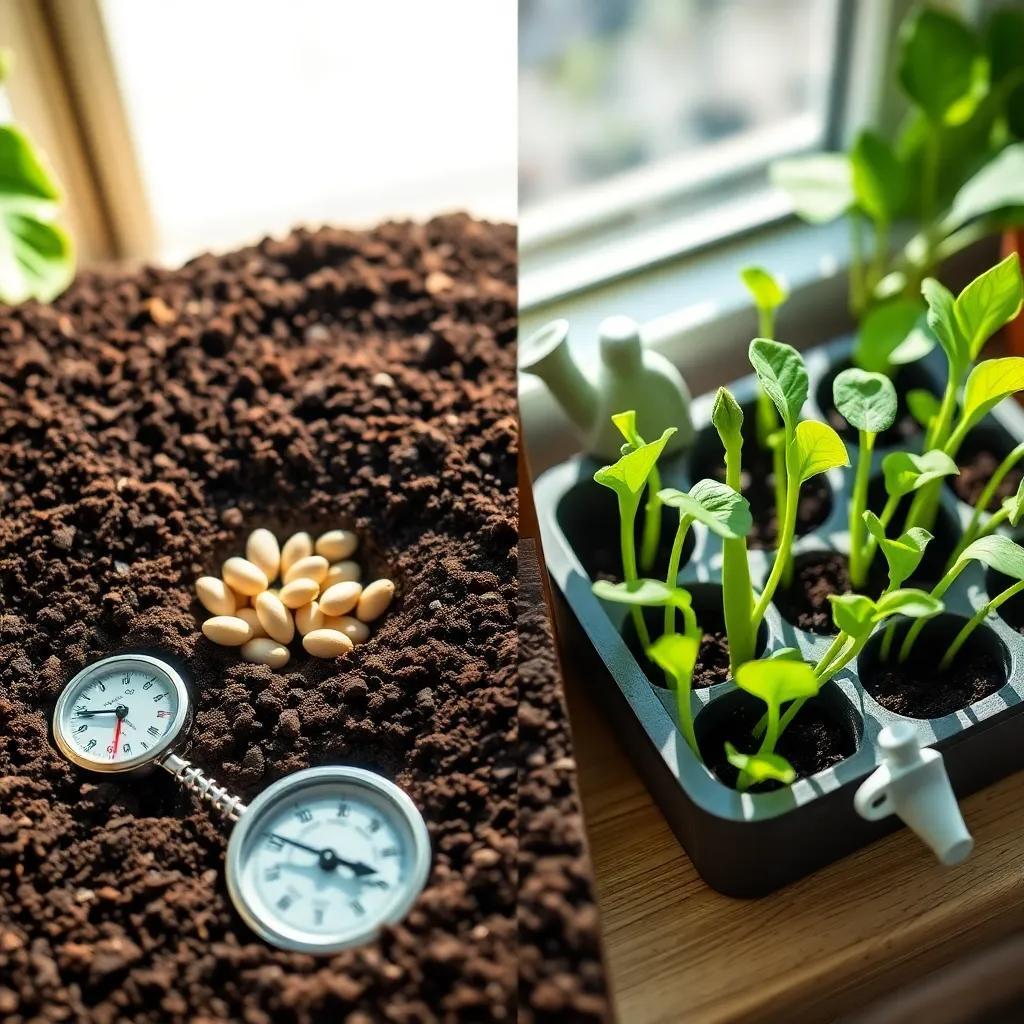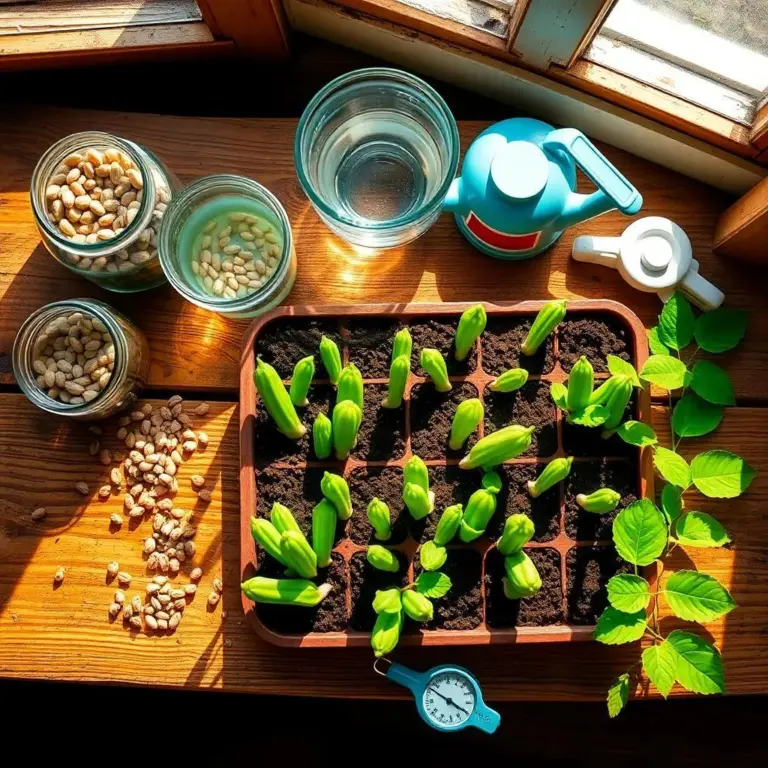Are you ready to grow some delicious okra? Gardening can be such a joyful adventure, especially when it comes to watching those little seeds sprout! In this article, I’ll share everything I’ve learned about how to help your okra seeds germinate successfully. Let’s dive into the world of gardening together and discover the secrets to growing healthy and vibrant okra plants!
Factors That Influence Okra Germination Success
When it comes to getting my okra seeds to sprout, a few key factors play a big role in their success! If you want a thriving okra plant, keeping these elements in mind can help you out immensely. Let’s take a closer look at what affects the germination of our green friends!
- Temperature: Okra seeds love warm weather! The ideal temperature for germination is between 75°F and 95°F (24°C to 35°C). If it’s too cold, they might just sit there, looking at you, instead of sprouting. To give them the best start, try to keep the soil nice and toasty.
- Moisture: Think of it like this: seeds are like little babies. They need the right amount of water to grow! Keep the soil moist, but not soggy. It’s a balancing act—too much water can lead to rot, and too little can leave your seeds feeling thirsty. A good tip is to check the soil with your finger; if it feels dry an inch down, it’s time to give it a drink!
- Seed Quality: Not all seeds are created equal! High-quality seeds sprout better and faster. When I’m picking seeds, I always choose fresh ones from trusted sources because old or damaged seeds can lead to disappointment.
- Soil Type: Okra prefers well-draining soil. Heavy clay can hold too much moisture, which is a no-no! Mixing in some organic matter, like compost, can help improve drainage and provide nutrients.
- Light: While okra seeds don’t need light to germinate, once my little seedlings pop up, they’ll be hungry for sunshine! Make sure they get plenty of light to grow strong and healthy.
By keeping these factors in mind, I set my okra seeds up for a successful start! Isn’t gardening fun? Let’s hop on to the next section and discover the ideal conditions for germinating okra seeds!
Ideal Conditions for Germinating Okra Seeds
So, you’re ready to plant your okra seeds, but do you know the ideal conditions that will help them germinate? I’ve got you covered! Here’s what I do to create the perfect environment for my seeds to sprout.
- Temperature Control: As I mentioned before, keeping the temperature between 75°F and 95°F (24°C and 35°C) is essential. One great way to monitor this is to use a soil thermometer. If it’s too cool, you can use a heat mat under your seed trays. That little extra warmth can work wonders!
- Consistent Moisture: I try to keep my soil evenly moist. I often check my seed trays daily! A gentle misting can help, and it’s a fun way to stay connected to my plants. Just remember, no one likes soggy soil, so avoid making puddles!
- Quality Seeds: Starting with quality seeds is a must! I always check for seeds that are fresh and with a high germination rate. The last thing I want is for my okra seeds to be disappointing!
- Depth Matters: I plant my okra seeds about half an inch deep (1.3 cm). This depth is perfect for moisture but also allows light for seedlings once they break through the soil. Too deep, and they struggle; too shallow, and they dry out. It’s all about that sweet spot!
- Soil Preparedness: Well-draining soil is a must! Before I plant, I make sure to prepare the soil by removing debris, rocks, and weeds. Mixing in compost really benefits the plants. They love it!
- Lighting Needs: Once those seeds sprout, they’ll need about 6-8 hours of direct sunlight each day. If I’m growing indoors, I use grow lights to help them get all the light they need.
By following these ideal conditions, I’m setting up my okra seeds for success. Let’s embrace the joy of gardening together and watch those seedlings flourish!

Average Timeframe for Okra Seed Germination
So, when can I expect those beautiful okra seeds to sprout? Great question! On average, okra seeds take about 7 to 14 days to germinate under the right conditions. That’s just about a week to two weeks of anticipation before witnessing those little green miracles poking through the soil!
But here’s the scoop—just like waiting for cookies to bake, there are a few things that can speed up or slow down this germination process. So let’s break it down:
- Temperature Matters: Warmer temperatures can work like magic! If I keep the soil around 85°F (29°C) or higher, I might see those seeds sprout in as little as a week. On the flip side, if it’s cooler than 70°F (21°C), things can slow down. I might be looking at a wait of two weeks or even longer!
- Moisture Level: Keeping that soil moist is essential! If the soil is dry, those seeds might just sit there twiddling their thumbs. Regular, gentle watering keeps the seeds happy and active.
- Seed Quality: Fresh seeds usually germinate faster. I always check that my seeds look healthy and vibrant. Older seeds might take a little longer to wake up!
As I watch my seeds sprout, I get so excited! Each little root that pushes through the soil is a step closer to enjoying juicy okra pods. So, whether I’m waiting patiently or checking in daily, I’m reminded that gardening is a beautiful journey of growth!
Tips to Enhance Okra Seed Germination Rates
Ready to boost those germination rates? I sure am! Here are some fun and easy tips that I’ve found work wonders for getting my okra seeds to sprout quickly and reliably!
- Pre-soak Your Seeds: One of my favorite tricks is to soak the seeds in water for 12 to 24 hours before planting. This helps soften that tough outer shell, making it easier for them to absorb water and sprout. It’s like giving them a little spa treatment!
- Scarify Your Seeds: If soaking isn’t your thing, try scarification! Just give the seed coat a gentle scratch with a file or sandpaper. This lets water in and speeds up germination. It’s a tiny step with big rewards!
- Use a Seedling Heat Mat: If I want to kick things up a notch, I’ll use a seedling heat mat. It keeps the soil warm and cozy, encouraging my seeds to germinate faster, even if the outside temperature isn’t cooperating!
- Consistent Moisture: Just like a good sponge cake needs the right amount of moisture, so do my seeds! I keep the soil lightly moist without flooding it. A gentle misting usually does the trick!
- Thin Out Seedlings: When my seeds sprout, I sometimes end up with too many seedlings in one spot. I thin them out to give the stronger ones space to grow. This helps avoid competition for nutrients and light.
By following these tricks, I’ve noticed my okra seeds sprouting faster and more reliably! Gardening can feel like a science experiment, and I love learning what works best for my garden.
Common Germination Issues and Troubleshooting Strategies
Even the best gardener can run into some pesky problems! Here are a few common germination issues I’ve faced, along with my favorite troubleshooting tips to tackle them. Let’s keep those okra seeds on track!
- Poor Germination Rate: If I notice that hardly any seeds are sprouting, I first check the seed quality. Are they fresh and viable? Sometimes, I need to plant fresh seeds and adjust those germination conditions.
- Seed Rot or Damping-Off: If my seedlings look weak or are collapsing, it might be too moist! I make sure to improve drainage and avoid overwatering. I also try to provide good air circulation around my plants to keep fungi at bay.
- Slow or Uneven Germination: If some seeds sprout quickly while others take their sweet time, I check the temperature and moisture levels. I want to make sure they’re optimal for everyone! A heat mat can help when it’s cooler.
- Pest Damage: Ah, those pesky garden pests! They can munch on tiny seedlings. I keep an eye out and use organic pest control methods, like a homemade spray or physical barriers, to protect my plants.
- Leggy Seedlings: If my seedlings look tall and spindly, they’re probably not getting enough light. I adjust their position to give them that much-needed 6-8 hours of sunlight or use a grow light. Strong light helps them grow sturdy!
By addressing these issues and being proactive, I can keep my okra plants thriving! Gardening is all about learning and adapting, and there’s always something new to discover. So let’s keep those seeds happy and watch our gardens flourish!

